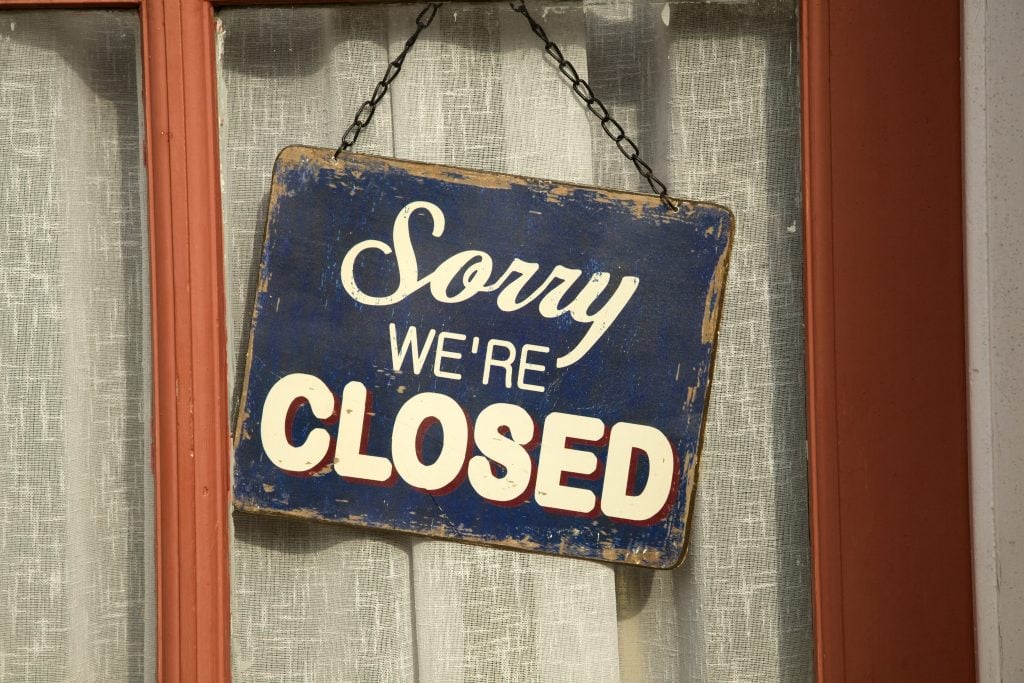While some of our art-world clients have been faring surprisingly well during the pandemic, many others are struggling to stay afloat—and those are the ones who call and e-mail us regularly. Here is a sampling of the types of questions we have received regarding the laws of bankruptcy and creditors’ rights.
I own a small gallery in Chelsea, and my accountant just told me that in addition to our day-to-day financial obligations, we have a $4 million credit line coming due and almost no money in the bank. What are my options?
Assuming your creditors won’t renegotiate the terms of your debts, you might take advantage of the protections offered under the US Bankruptcy Code, which was amended in February 2020 and again shortly thereafter under the CARES Act (Coronavirus Aid, Relief and Economics Security Act). You could restructure your gallery’s business under Chapter 11 of the Bankruptcy Code—or simply liquidate your business altogether under Chapter 7.
You are talking about too many chapters here and I am still struggling with your introductory paragraph. What’s the difference between Chapter 11 and Chapter 7 of the Bankruptcy Code?
Good question. Filing under Chapter 7 is basically the end of the road for a business. A trustee is appointed by the court, the business’s operations are wound down, its assets are sold off to pay its debts (or as much of its debts as the assets allow), and the doors are closed for good. By contrast, under a Chapter 11 bankruptcy filing, the court-appointed trustee works with the creditors and the business owner to put a debt payment plan into place and keep operations going, with the hope that there will be better days ahead and the business will eventually turn around.
Got it. Why don’t all troubled businesses like mine just file for bankruptcy under Chapter 11?
Until the recent change in the law, Chapter 11 bankruptcies were poorly suited to small businesses like your gallery. They were expensive and cumbersome, and often took too long to implement. That is why, in the past, many businesses ended up having to liquidate under Chapter 7 even after restructuring under Chapter 11.
So, what has changed exactly?
The February 2020 amendment created Subchapter 5 of Chapter 11 of the US Bankruptcy Code, which made it easier for small businesses with less than approximately $2.7 million in debt to reorganize and keep going. Under the CARES Act, these provisions were temporarily expanded to include businesses with up to $7.5 million in debt.
English translation, please.
Simply put, your gallery can file for bankruptcy under Chapter 11 and take advantage of the new business-friendly provisions. You will be able to restructure your debt less expensively and with less red tape than under the old law, and ideally weather this financial storm and keep your gallery going.

Visitors outside a gallery on 27th Street in New York’s Chelsea gallery district. Photo: Etienne Frossard.
How does it work in practice?
You make a bankruptcy filing, which includes financial information about your business and its debts, together with a detailed restructuring plan. If the plan seems fair to your creditors, a judge may enforce it and you can go on with your business.
One of my creditors hates me and, out of spite, would never agree to anything. What happens if she objects to the plan?
One of the benefits of Subchapter 5 is that a single creditor cannot block your restructuring plan. Unlike in Chapter 11 proceedings, creditors do not even vote on a restructuring plan under a Subchapter 5 filing. According to the statute, if the court finds that the debtor will be able to make all required payments under the plan—or, if there is just a “reasonable likelihood” that the debtor will be able to make these payments, that the plan contains “appropriate remedies” to protect creditors—then the bankruptcy restructuring will be approved.
This sounds promising. How long do I have to make the filing?
The temporary provisions covering businesses with up to $7.5 million in debt are due to expire in late March 2021. After that, the debt limit reverts back to $2.7 million. The other deadline to keep in mind is the requirement that a restructuring plan be submitted to the court within 90 days of the filing. So get moving if this is of interest!
What will happen to my gallery’s lease if I file for bankruptcy?
We don’t have a good answer to this one. Bankruptcy courts have yet to consider how the traditional Chapter 11 requirement that a tenant must keep up with rent reconciles with the new Subchapter 5 provision permitting a debtor to pay out claims over time—so it will likely be left to a judge to decide on this issue.
I am an artist and suspect that my gallery owner is the one writing to you with all these questions. What happens to the artwork that I consigned if my gallery declares bankruptcy?
Fortunately for you, New York law has your back here. After the famous Salander O’Reilly Galleries bankruptcy debacle in 2007, in which many artists and other consignors lost their artworks to the gallery’s creditors, New York State amended Article 12 of the Arts & Cultural Affairs Law specifically to protect artists who consign their work to galleries.

Lawrence Salander with his former wife Julie.
Photo: Patrick McMullan.
What protection do artists now receive?
Artwork consigned by artists becomes trust property that must be maintained by the gallery for the benefit of those artists. If the gallery goes bankrupt, the artwork cannot be seized by creditors and has to be returned to the consigning artists. As an added protection, the gallery is also obliged to hold proceeds from the sale of consigned artworks in a separate bank account from the gallery’s operating account.
Gallery owner here, coming back with a follow-up question. I didn’t know we had to maintain a separate bank account for proceeds from the sale of works consigned by artists. What’s my risk if we don’t?
New York has put teeth into this requirement by providing for criminal penalties in the event of a violation. And the state definitely takes crimes involving dealers very seriously. Gallerist Larry Salander, for one, was sentenced to a prison term of between 6 and 18 years.
I’m a collector who also consigns works to this struggling gallery. It’s all fine and dandy that the gallery and consigning artists are protected in a bankruptcy, but what about me?
New York State law does not provide specific protections for collectors who consign art to a gallery. That is why we recommend that all consignors file a UCC financing statement before making any gallery consignment. The filing puts creditors on formal legal notice that the artwork is not owned by the gallery and cannot be seized if the gallery goes bankrupt.
Where do I make this filing?
It depends on the type of debtor. UCC filings are usually made with the Department of State or equivalent governmental agency either in the state where the debtor is organized or the state where it maintains its principal place of business. Because a UCC filing must comply with certain legal formalities to be effective, we suggest asking a lawyer to handle this.
It’s me, the gallery owner, chiming in again: Let’s say I do make a bankruptcy filing under the new Subchapter 5 regulations. Can I keep my equity in the gallery and maintain control over its operations?
Yes. Under Subchapter 5, the business owner may keep his or her equity and retain control over the business. This is true even if creditors are not being paid in full, as long as projected disposable income is devoted to repaying them. This option is unavailable under normal Chapter 11 provisions, where debtors are required to pay their creditors in full in order to keep equity.
So Subchapter 5 seems like a good choice for small businesses in financial trouble, right?
Right. Good luck!
Charles Danziger, Esq. and Thomas C. Danziger, Esq. are partners in the New York firm Danziger, Danziger & Muro, LLP, specializing in art law. Go to DANZIGER.COM for more information. The authors thank Eugenia Bullock for her extensive research and writing assistance on this article. Some facts have been altered for reasons of client confidentiality or have been made up out of whole cloth. Nothing in this article is intended to provide specific legal advice.








